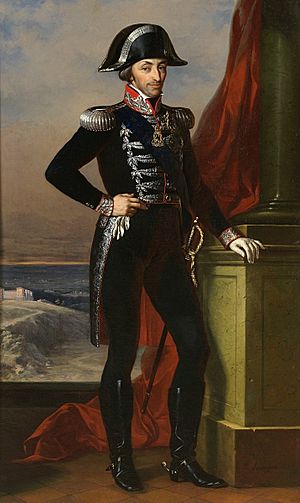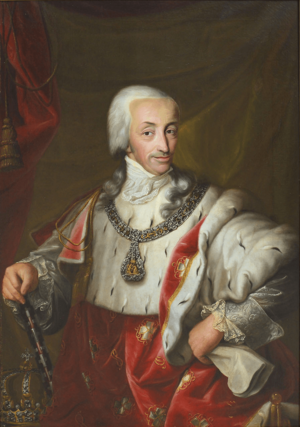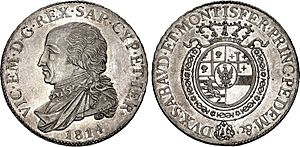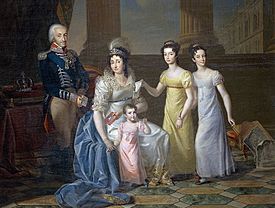Victor Emmanuel I of Sardinia facts for kids
Quick facts for kids Victor Emmanuel I |
|||||
|---|---|---|---|---|---|

Posthumous portrait by Tommaso Lorenzone
|
|||||
| King of Sardinia and Duke of Savoy | |||||
| Reign | 4 June 1802 – 12 March 1821 | ||||
| Predecessor | Charles Emmanuel IV | ||||
| Successor | Charles Felix | ||||
| Born | 24 July 1759 Royal Palace of Turin, Turin, Kingdom of Sardinia |
||||
| Died | 10 January 1824 (aged 64) Castle of Moncalieri, Turin, Kingdom of Sardinia |
||||
| Burial | Basilica of Superga, Turin | ||||
| Consort | Maria Teresa of Austria-Este | ||||
| Issue among others... |
Maria Beatrice, Duchess of Modena Maria Teresa, Duchess of Parma Maria Anna, Empress of Austria Maria Christina, Queen of the Two Sicilies |
||||
|
|||||
| House | House of Savoy | ||||
| Father | Victor Amadeus III of Sardinia | ||||
| Mother | Maria Antonia Ferdinanda of Spain | ||||
| Religion | Roman Catholicism | ||||
Victor Emmanuel I (born Vittorio Emanuele; 24 July 1759 – 10 January 1824) was a powerful ruler. He was the Duke of Savoy and King of Sardinia from 1802 to 1821. His time as king ended in 1821 when he gave up his throne. This happened because of a big change called a liberal revolution. After he stepped down, his brother, Charles Felix, became the new King of Sardinia. Victor Emmanuel was the son of King Victor Amadeus III of Sardinia and his wife, Maria Antonia Ferdinanda of Spain. In 1789, he married Maria Theresa of Austria-Este. They had seven children together. One of their daughters later became the Empress of Austria.
Contents
Life Story of Victor Emmanuel I
Victor Emmanuel was born on 24 July 1759. His birthplace was the Royal Palace of Turin in Turin, Italy. He was the second son of King Victor Amadeus III of Sardinia. His mother was Maria Antonia Ferdinanda of Spain.
Early Life and French Invasion
From birth, Victor Emmanuel was known as the Duke of Aosta. In the late 1700s, his father fought against the new French government. But his father's forces were defeated. They had to sign a peace agreement called the Treaty of Paris in 1796.
Soon after, his father passed away. In 1798, France took over many of their lands. Victor Emmanuel's older brother, Charles Emmanuel IV, was the king at that time.
Charles Emmanuel and his family had to move to Sardinia. This island was the only part of their kingdom that France had not conquered. Charles Emmanuel did not focus much on ruling Sardinia. He lived in other cities on the mainland. In 1802, his wife died. Since they had no children, Charles Emmanuel decided to give up his throne. He passed it to his younger brother, Victor Emmanuel.
Becoming King and Ruling Sardinia
Victor Emmanuel became king on 4 June 1802. He was known as Victor Emmanuel I. For the next twelve years, he ruled Sardinia from the city of Cagliari. During this time, he created the Carabinieri. This was a special police and military force. Today, the Carabinieri are still an important part of Italy's military.
Returning to Turin and New Rules
In 1814, Victor Emmanuel was able to return to Turin. His kingdom was made whole again by the Congress of Vienna. This important meeting of European leaders also added new lands to his kingdom. The former Republic of Genoa became part of his rule. This area became important for the Sardinian Navy.
When he returned, Victor Emmanuel changed many things. He removed the new freedoms that had been put in place by the French. He brought back older, stricter laws. He also made it harder for some groups, like Jews and Waldensians, to have equal rights. He gave the Church more control over education.
Victor Emmanuel also wanted to expand his kingdom. He hoped to gain control of Lombardy. This area was part of the Austrian Empire. Many people there did not like Austrian rule. This led to some disagreements with Austria.
Abdication and Later Life
In March 1821, a revolution started in Italy. People wanted more freedom and a new constitution. This movement was led by groups like the Carbonari. It seemed that Victor Emmanuel might agree with their anti-Austrian ideas.
However, Victor Emmanuel did not want to give his people a liberal constitution. So, on 13 March 1821, he decided to give up his throne. He passed it to his brother, Charles Felix. Charles Felix was not in Sardinia at the time. So, Victor Emmanuel temporarily put Charles Albert in charge. Charles Albert was next in line to the throne after Charles Felix.
After giving up his throne, Victor Emmanuel lived in different cities. He returned to the Castle of Moncalieri in 1824, where he passed away. He is buried in the Basilica of Superga.
Family and Children
On 21 April 1789, Victor Emmanuel married Archduchess Maria Teresa of Austria-Este. She was the daughter of Ferdinand, Duke of Modena.
They had six daughters and one son. Their son died when he was very young.
- Maria Beatrice Victoria Josepha of Savoy (1792–1840); she married her uncle, Francis IV, Duke of Modena.
- Maria Adelaide Clothilde Xaveria Borbonia of Savoy (1794–1795); she died as a baby.
- Charles Emanuel (1796–1799); he died from smallpox.
- A daughter (1800–1801); she also died as a baby.
- Maria Teresa Fernanda Felicitas Gaetana Pia of Savoy (1803–1879); she married Charles II, Duke of Parma.
- Maria Anna Ricciarda Carlotta Margherita Pia of Savoy (1803–1884); she married Ferdinand I of Austria.
- Maria Cristina Carlotta Giuseppina Gaetana Elise of Savoy (1812–1836); she married Ferdinand II of the Two Sicilies.
See also
 In Spanish: Víctor Manuel I de Cerdeña para niños
In Spanish: Víctor Manuel I de Cerdeña para niños




